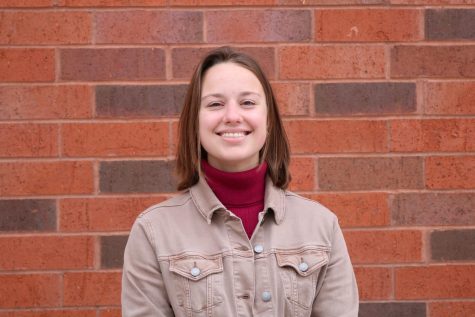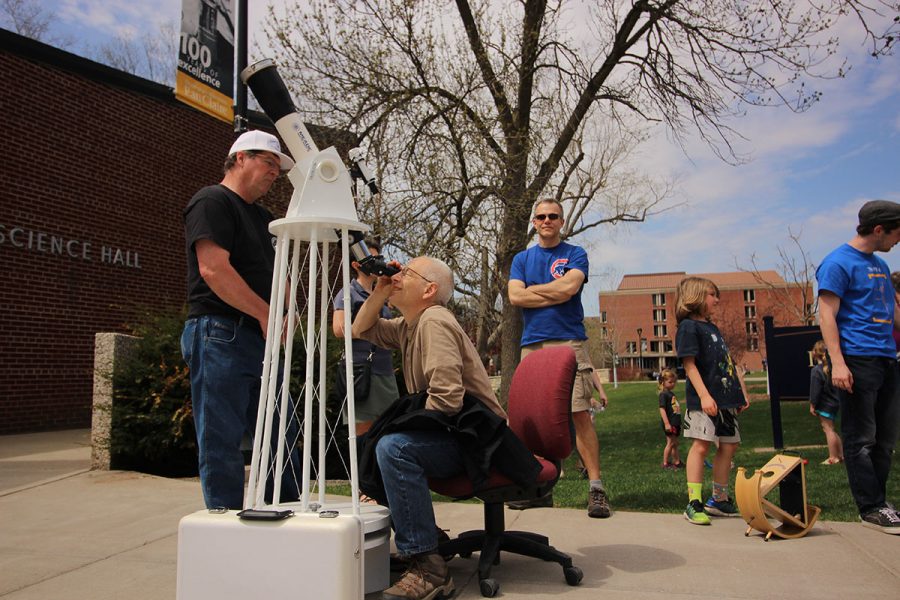To Eau Claire and beyond
Astronomy Day features telescopes, a planetarium show and educational displays
Photo by Gabbie Henn
Geared toward learners of all ages, Astronomy Day was free and open to the public. It was hosted by the Chippewa Valley Astronomical Society, a local club with an observatory in Fall Creek.
At 12:34 p.m. on May 5, constellations dotted the sky, bushing up against the milky way and arching over the horizon. Minutes later, the magic was over. The moon made way to the dusty-yellow glow of the sun.
The show in L.E. Phillips Planetarium was complete. The audience shuffled out of the dim room, their eyes squinting at the alarming afternoon light.
The planetarium show was one piece of Astronomy Day, an annual event presented by the Chippewa Valley Astronomical Society (CVAS) and UW-Eau Claire’s physics and astronomy department. Geared toward learners of all ages, Astronomy Day was free and open to the public.
The fair’s booths lined the entrance of Phillips Science Hall. Telescopes aimed at the sun occupied the sidewalks in front of the building. An astronomical club member attended each stop.
The planetarium show was piloted by Laura Hurd, whose repertoire includes hosting an outdoor night sky show and working at a planetarium in Duluth for four years.
“I’ve always said that if I could live in a planetarium, I would,” Hurd said.
Hurd’s presentation highlighted several famous constellations like Cassiopeia, Leo the Lion and Draco the Dragon. Hurd also pointed out Betelgeuse, Sirius and other bright stars in the night sky.
Actually, Hurd said, the Big Dipper alone is not a constellation. It is an asterism and part of the larger constellation called Ursa Major. Likewise, the Little Dipper is part of Ursa Minor. Each constellation holds a glimpse of history.
“There’s a lot of huge value to learning about the sky,” Hurd said. “It’s fun to learn about the stories.”
Hurd said stars can also be used for locating cardinal directions.
After the planetarium show, guests peered at the real sky through bulky telescopes. Using safe lenses that filter harmful rays, the telescopes were focused directly at the sun.
From the viewfinder, the sun appeared a tranquil golden orb. The CVAS members caring for the telescopes said they could see one faint sunspot on its otherwise calm surface.
Back inside Phillips Hall, there were tables filled with tri-fold displays, artifacts and astronomical equipment.
Christopher Moore, a high school student and CVAS member, stood behind a table that boasted an infrared imaging camera and a slice of silica similar to what’s found on spaceships. Visitors could use the camera to see the infrared light radiating from their bodies.
Moore said he is a member of CVAS because he is passionate about studying the universe. Moore said he thinks people often forget the enormity of the universe and focus on the corner of it they know the best: Earth.
“We’re just stuck in one part of it,” Moore said, “and it is this vast, vast universe.”
Uncovering outer space — the great unknown — gives Moore clarity.
“It helps you learn about who you are, where you are,” Moore said.
A few tables down from Moore, Gwen Kieffer lifted coffee mugs depicting the different gravitational pulls found on planets in the solar system. The mug labeled Venus is filled with sand, while the mug from Pluto is so light it would need a refill if it were an actual cup of coffee.
Kieffer, a first-year elementary education student at Eau Claire, said Astronomy Day peaked her curiosity.
“It’s important to keep discovering,” Kieffer said.
CVAS will host an observational event open to the public at 9:23 p.m. on May 12 at Hobbs Observatory in Fall Creek. More information about the event can be found on the organization’s website.

Neupert is a fourth-year journalism student at UW-Eau Claire. She is the executive producer of Engage Eau Claire on Blugold Radio Sunday. In her spare time, Neupert's working on becoming a crossword puzzle expert.

